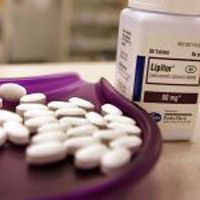Statin Therapy Not Linked to Risk of Fracture
Fixed doses of rosuvastatin did not reduce the risk of fracture in older patients, according to research published in JAMA Internal Medicine.
Statin therapy did not reduce risk of fracture for patients with elevated high-sensitivity C-reactive protein (hs-CRP), according to research published in JAMA Internal Medicine.

Researchers from the Montefiore Medical Center and Albert Einstein College of Medicine in New York evaluated 431 reported and confirmed incident fractures between 2003 and 2006 in order to determine whether statin therapy reduced the risk of fractures and whether baseline levels of hs-CRP were associated with the risk of fracture.
The patients were recruited from Justification for the Use of Statins in Prevention: an Intervention Trial Evaluating Rosuvastatin (JUPITER), an international, randomized, double-blind, and placebo-controlled study of nearly 18,000 men older than 50 years and women older than 60 years. The participants’ hs-CRP levels were at least 2 mg/ L. The participants were treated with 20 mg daily rosuvastatin calcium or placebo and they were followed for no longer than 5 years.
Patients were excluded if the development of fractures was related to the history of alcohol abuse, cancer within the last 5 years prior to JUPITER enrollment, diabetes, chronic inflammatory conditions (such as lupus, severe arthritis, and inflammatory bowel disease) use of post menopausal hormone therapy, or long term use of oral glucocorticoids.
History of a previous fracture was reported by just over a third of participants, with 57.7% of those participants reporting 1 to 3 fractures in the 20 years prior to the investigation. The median hs-CRP levels were 4.3 mg/ L and 4.2 mg/ L in the placebo and rosuvastatin groups, respectively.
Of the total 431 incident fractures that were reported and confirmed, 221 fractures were confirmed among patients who were allocated rosuvastatin; 210 fractures were confirmed among placebo participants. The incidence of fracture in the 2 groups were 1.20 and 1.14 per 100 person years for the rosuvastatin and placebo groups, respectively. The researchers determined baseline hs-CRP levels were not associated with the risk of fractures.
“Among men and women with elevated hs-CRP level enrolled in a large trial of rosuvastatin therapy for cardiovascular disease, statin therapy did not reduce the risk of fracture,” the authors wrote, noting that their findings are aligned with prior studies’ results. “Higher baseline hs-CRP level was not associated with an increased risk of incident fracture.”
The authors did comment that the short treatment duration may not have been sufficiently long enough to achieve a beneficial effect of statin use on bone. However, their analysis suggested no emerging benefits in participants treated for 3 to 5 years. Another limitation was created in the study because the researchers used fixed statin doses, which they wrote does not rule out the possibility that higher doses of statin may prevent fracture.
